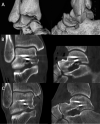Antiresorptive treatment and talar collapse after displaced fractures of the talar neck: a long-term follow-up of 19 patients
- PMID: 33870825
- PMCID: PMC8381918
- DOI: 10.1080/17453674.2021.1915017
Antiresorptive treatment and talar collapse after displaced fractures of the talar neck: a long-term follow-up of 19 patients
Abstract
Background and purpose - Displaced fractures of the talar neck are associated with a high risk of structural collapse. In this observational analysis we hypothesized that pharmacological inhibition of osteoclast function might reduce the risk of structural collapse through a reduction in bone resorption during revascularization of the injured bone.Patients and methods - Between 2002 and 2014 we treated 19 patients with displaced fractures of the talar neck with open reduction and internal fixation. Of these, 16 patients were available for final follow-up between January and November 2017 (median 12 years, IQR 7-13). Among these, 6 patients with Hawkins type 3 fractures and 2 patients with Hawkins type 2b fractures received postoperative antiresorptive treatment (7 alendronate, 1 denosumab) for 6 to 12 months. The remaining 8 patients received no antiresorptive treatment. The self-reported foot and ankle score (SEFAS) was available in all patients and 15 patients had undergone computed tomography (CT) at final follow-up, which allowed evaluation of structural collapse of the talar dome and signs of post-traumatic osteoarthritis.Results - The risk for partial collapse of the talar dome was equal in the 2 groups (3 in each group) and post-traumatic arthritis was observed in all patients. The SEFAS in patients with antiresorptive treatment was lower, at 21 points (95% CI 15-26), compared with those without treatment, 29 points (CI 22-35).Interpretation - Following a displaced fracture of the talar neck, we found no effect of antiresorptive therapy on the rate of talar collapse, post-traumatic osteoarthritis, and patient-reported outcomes.
Figures





Similar articles
-
[Surgical management of talus fractures: mid-term functional and radiographic outcomes].Acta Chir Orthop Traumatol Cech. 2013;80(2):165-70. Acta Chir Orthop Traumatol Cech. 2013. PMID: 23562263 Czech.
-
Open reduction and stable fixation of isolated, displaced talar neck and body fractures.J Bone Joint Surg Am. 2004 Oct;86(10):2229-34. doi: 10.2106/00004623-200410000-00014. J Bone Joint Surg Am. 2004. PMID: 15466732
-
The prognostic value of the hawkins sign and diagnostic value of MRI after talar neck fractures.Foot Ankle Int. 2014 Dec;35(12):1255-61. doi: 10.1177/1071100714547219. Epub 2014 Aug 12. Foot Ankle Int. 2014. PMID: 25116131
-
Low-Energy Hawkins Type III Talar Neck Fracture-Dislocation With Neurovascular and Tendon Entrapment in a Pediatric Patient.J Foot Ankle Surg. 2017 Nov-Dec;56(6):1288-1291. doi: 10.1053/j.jfas.2017.05.007. Epub 2017 Aug 1. J Foot Ankle Surg. 2017. PMID: 28778631 Review.
-
Talar Neck Fractures Treated Using a Highly Selective Incision: A Case-Control Study and Review of the Literature.J Foot Ankle Surg. 2016 May-Jun;55(3):450-5. doi: 10.1053/j.jfas.2016.02.002. Epub 2016 Mar 5. J Foot Ankle Surg. 2016. PMID: 26961417 Review.
References
-
- Abrahamsen B.Adverse effects of bisphosphonates. Calcif Tissue Int 2010; 86(6): 421–35. - PubMed
-
- Agarwala S, Shah S, Joshi V R.. The use of alendronate in the treatment of avascular necrosis of the femoral head. J Bone Joint Surg Br 2009; 91-B(8): 1013–8. - PubMed
-
- Annappa R, Jhamaria N L, Dinesh K V, Devkant, Ramesh R H, Suresh P K.. Functional and radiological outcomes of operative management of displaced talar neck fractures. Foot (Edinb) 2015; 25(3): 127–30. - PubMed
-
- Chen C H, Chang J K, Lai K A, Hou S M, Chang C H, Wang G J.. Alendronate in the prevention of collapse of the femoral head in nontraumatic osteonecrosis: a two-year multicenter, prospective, randomized, double-blind, placebo-controlled study. Arthritis Rheum 2012; 64(5): 1572–8. - PubMed
Publication types
MeSH terms
Substances
LinkOut - more resources
Full Text Sources
Other Literature Sources
Medical
